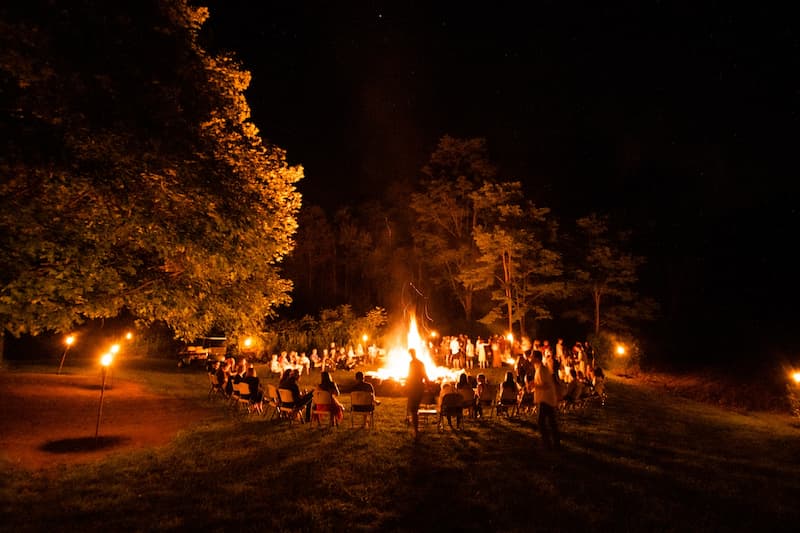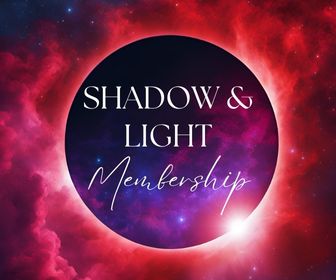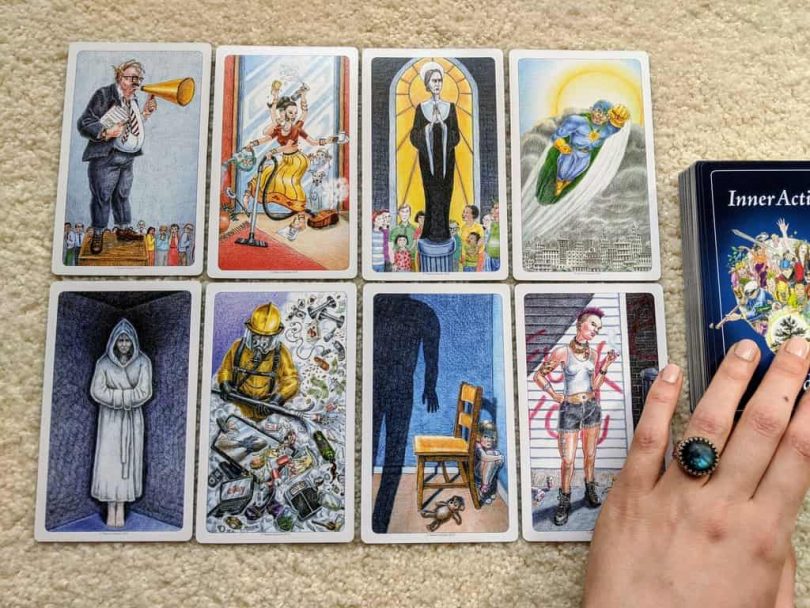Of all the psychological and spiritual tools out there, Internal Family Systems (IFS) is one of the most powerful.
Never heard of it? That’s okay. Most people haven’t. And my intention is to change that.
Ignore the complicated-sounding name for a sec and hear me out:

Spiritual Wanderer Course:
⭐️⭐️⭐️⭐️⭐ "I started the Spiritual Wanderers Course a short while ago and for the first time in twelve years I have started to experience love, acceptance and compassion for myself and within myself. Thank you so much." – Vivienne S.
Internal Family Systems (IFS) is such a useful inner soul work approach because it helps us to create inner balance and rediscover our spiritual Wholeness.
In fact, I have found IFS so useful on my spiritual awakening path that I regularly use its approach to practice mindful self-compassion and soul retrieval (aka., integrating disconnected parts of the psyche).
Want to learn the basics of IFS? Keep reading, and I’ll walk you through it …
Table of contents
What is Internal Family Systems?

Also referred to as Parts Work, Internal Family Systems is a form of psychotherapy that focuses on reintegrating and harmonizing the inner parts of us (also known as our subpersonalities). Developed by Richard C. Schwartz in the 1980s, Internal Family Systems is based on the premise that we all contain an inner family composed of many different parts. At the core of ourselves exists a wise, calm, and loving Self that we can seek to reunite with during this therapeutic process.
We All Have an Inner Family

As professor and author Tom Holmes writes, we all have an inner family composed of different parts:
In the Buddhist tradition these states are called mental formations or habit patterns. Piaget and the cognitive behaviourist refer to them as schemas. Psychosynthesis refers to them as sub personalities and psychodynamic psychologists refer to them as ego states. We will call them ‘parts.’
While some of these inner parts help to protect and motivate us, other parts are highly destructive and dysfunctional. The purpose of IFS is to bring harmony to our inner family of parts, reinstating our core Self (the wise and loving part of us) as the head of this inner family.
Examples of Inner Parts That Most of Us Contain

The core purpose of Internal Family Systems is to help us clearly identify and work with our parts so that we can approach life mindfully, seated in our wise and compassionate Center (or Self).
Common parts that most of us contain include, for example:

Shadow & Light Membership:
⭐️⭐️⭐️⭐️⭐ "Shadow and Light’s weekly guidance always rings true to my heart. Thanks for acknowledging my shadows and inviting my inner light. I always get excited to open the Shadow and Light emails on Sunday!" – Angela M.
- A magical child part
- A wounded child part
- A motherly/fatherly part
- A sensual part
- An angry part
- A rebellious part
- An insecure teenage part
- A lazy part
- A practical part
- A gluttonous part
- A problem-solving part
- An innocent part
- A judgmental part
- A self-destructive part
- An adventurous part
- … and so forth
There are virtually an unlimited number of parts that we contain. At any one time, a handful of parts might be activated within us, but usually, we’re operating in only one or two parts at a time (e.g., the responsible adult part, the mother part, the student part).
What Happens When Our Inner Parts Become Destructive?

When our inner parts become destructive (aka., when they sabotage our dreams, harm others, or perpetuate mental and emotional illness), it is as if we become possessed by them.
Internal Family Systems therapy calls this becoming blended with these parts.
Blending happens when a part overtakes our consciousness, and we temporarily become it. For example, we might declare, “I want to KILL him,” in a moment of anger and genuinely feel that desire. A more centered approach is thinking, “A part of me wants to kill him.”
The solution to this dilemma is to become unblended, that is, to find a way to step back, see what part is taking over, and perceive it from the wise and compassionate viewpoint of the central Self.
In other words, Internal Family Systems is all about returning us to our True Nature and reconnecting us with our Souls. It is a sublime mix of psychology and spirituality and is, therefore, an invaluable practice on our spiritual journeys.
3 Types of Parts That Are Wreaking Chaos Inside of You

Our inner parts can either be healthy or unhealthy. (And, of course, there are some that are a little bit of both.)
When doing Parts Work, we’re exploring the chaotic, wounded, and dysfunctional parts of you. These parts tend to take on one of three main roles:
- Managers – These are parts of us that organize and protect our system. Their job is to help shield and safeguard us from the external and internal world and suppress the pain of our inner Exiles (which we’ll explore below). Manager parts tend to be controlling, perfectionistic, intellectual, obsessive, critical, reclusive, emotionally detached, hypervigilant, phobic, and tend to suffer from anxiety and depression.
- Firefighters – These are parts of us that will do anything to make the pain go away (that our inner Exile parts carry). They’ll not only put out the fire of pain within us, but they’ll also destroy the whole house in the process if necessary. Their role is to stop us from feeling anything too painful, but unlike Manager parts, Firefighter parts go to the extreme. Firefighter parts tend to be impulsive, illogical, addictive, and destructive and will extinguish anything that is associated with our trauma by any means possible.
- Exiles – These are the lost and buried parts within us that carry trauma. Manager parts try to keep these parts of us at bay by distracting and administrating our daily lives (through work, responsibilities, self-judgment, etc.). On the other hand, Firefighter parts within us try to keep Exile parts away through extreme means such as addictions, purging, self-harm, affairs, etc. – this is done in a desperate attempt to protect our system. As a result of being suppressed by our inner Managers and forcefully withheld by our Firefighters, Exile parts often try to escape their prison cells. Their deepest desire is to be loved, yet they are frozen in the past. They are defined by feelings of terror, rage, helplessness, and collapse.
To make matters more difficult, there can be internal conflict between these inner parts. For instance, Managers can fight Firefighters (and vice versa), and of course, Managers and Firefighters actively fight against our inner Exiles.
So, how do we work with these dysfunctional parts?
Would you like to save this?
Your information will never be shared.
Download FREE IFS Worksheets!
Go deeper with an Internal Family Systems journaling prompt + printable meditation mandala!
How to Connect With Your Soul Through Parts Work (Internal Family Systems)

To create inner psychological and spiritual balance, we need to become unblended from these inner parts and learn to step into our Self, which is our True Center.
Your core Self is the eye of the storm, the non-judgmental, creative, curious, wise, and relaxed part of you that holds all these conflicted parts within you in the arms of self-compassion.
To connect with this Self (which is another way of saying your Soul), you will need to practice becoming mindful of the different parts within you.
Healing, which is a natural result of operating from your Soul Center, means identifying, acknowledging, appreciating, and learning about your inner parts and becoming unblended from them.
By learning to stay within your Soul Center (Self), you will create more safety within your system, which will help to bring your inner Managers and Firefighters back into balance, welcoming back the presence of your lost Exile parts.
While this all may sound complex, it’s not. Of course, I recommend seeking out a trained Internal Family Systems therapist if you’re dealing with severe issues. But if you’re having mild difficulties, doing Parts Work is quite a straightforward process and, in my opinion, quite enjoyable at times!
Don’t expect to get instantaneous results or to be good at Parts Work immediately. Instead, see this process as a long-term ongoing practice that can support your psychological and spiritual growth.
Here are a few simple ways of beginning Parts Work:
1. Become familiar with your inner family

What parts dominate your internal landscape? Answering this question is the best way to begin Parts Work and, therefore, reconnecting with your Soul. If you can’t distinguish your inner parts from each other, it will be hard to unblend from them and be Soul-led.
To start this practice, think about a situation in life that created a strong reaction within you. It’s also okay to start small with this activity. Connect with a thought, feeling, or memory of something that upset you. Perhaps someone shouted at you while you were driving the other day. Perhaps your co-worker did something behind your back. Whatever it is, connect with that memory/feeling/thought.
Next, notice the feelings in your body that accompany this distressing situation. What kind of thoughts do you have surrounding this circumstance? If you were to give an image to this part of you, what would it look like? Feel free to incorporate journaling into this practice.
You might, for example, reflect on an argument you had with your partner the other night. Perhaps as you tune in, you feel a sense of smallness and constriction in your body. You might have thoughts such as, “S/he will never understand me. I’m all alone.” An image might form in your mind of a petulant teenager – and this is the part of you that was active during the argument.
You can also become familiar with your inner family by reflecting on your daily life. What primary roles do you play? What emotions dominate your inner landscape during the day? What are your goals, dreams, and interests? What are you afraid of? These questions will help you to reveal your inner parts.
You can learn about how to establish a journaling practice in my how to journal article.
2. Practice naming and greeting your inner parts

The more familiar you become with your inner family of parts, the more you will be able to name and greet them mindfully – without getting possessed by them.
At different moments of the day, make a habit of pausing, connecting with your breath, and noticing what part is active within you at the moment. Then, greet that part with kindness. This is a simple Soul-centered practice that will help you to reconnect with your Soul gradually.

Spiritual Awakening Bundle:
Find your spiritual purpose. Deepen your self-understanding. Learn to embrace who you are. Let us show you how …
For example, you might mentally pause while driving and observe what’s going on within you. You might observe your mind worrying about a work assignment and how you’re going to get it done. As you take a step back from that part, you may like to greet this Worry part with kindness, saying a simple, “Hello there, Worry part, thanks for stopping by.”
In response to this practice, you might notice other parts within you emerging with a vengeance (after all, their job is to try and protect your ego from any perceived changes/threats). You might notice an inner Skeptic part mocking your practice of naming and greeting inner parts. Or you may notice an inner Critic, Judge, or Bully trying to take over your consciousness again. Simply name and greet these parts with kindness.
If you work best with visual aids, I highly recommend looking into getting yourself the Inner Active Cards deck. This is a fantastic way of familiarizing yourself with the different parts of yourself in a fun, interactive way.
3. Connect with your inner Self (Soul) every day

The beauty of the Internal Family Systems practice is that it emphasizes the central importance of the Self or Soul – and also that identifying, acknowledging, appreciating, and learning about your inner parts creates more inner psychological and emotional clarity. This inner clarity will make it easier to live more and more from the warm and serene seat of the Self/Self. It’s a beautiful psychospiritual system!
To connect with your inner Self or Soul each day, there are a number of practices you can try:
- Do a Metta (lovingkindness) or heart-centered meditation every morning
- Pause throughout the day and mindfully connect with your breath
- Practice self-love in conjunction with mirror work
- Use art to express your inner Self (drawing mandalas is a wonderful place to start)
- Make space for introspective and reflective journaling to increase inner clarity
- Spend time practicing self-forgiveness
- Connect with your inner Spiritual Guide part to help you stay Soul-centered (you can do this through a self-guided meditation)
- Sign up to our Shadow & Light membership, which incorporates IFS principles amongst other practices for ongoing spiritual guidance, accountability, and healing!
This is not an exhaustive list, but there are some good suggestions here to help you get started.
The more familiar you become with that clear, calm, compassionate, curious, and wise Center within you, the more you will live in a state of balance. Instead of your inner parts overriding your consciousness, you’ll be able to become aware of them, treating them with love and respect (without blending with them).
***
I hope that I’ve inspired you to dive more deeply into this wonderful topic.
Internal Family Systems or Parts Work is a powerful tool for all those who recognize the importance of honoring our humanity and divinity. Psychology and spirituality are two sides of the same coin, and both are needed in order to find balance, joy, peace, and freedom – we’ve written more about this need for a psychospiritual approach in our spiritual psychology article.
To have a clear mind is to have a clear body and heart and, therefore, a clear access to your Soul. Parts Work practice is one of the best ways to find this clarity.
For extra guidance, I highly recommend checking out Tom and Lauri Holmes’ book “Parts Work: An Illustrated Guide to Your Inner Life” or “Introduction to Internal Family Systems” by Richard Schwartz
Tell me, what does your internal family look like? Who are the main players? I’d love to hear from you.
Three paths to inner transformation – here’s how I can help you go deeper:
1. The Spiritual Wanderer Course: Are you feeling lost, adrift, and unsure of your life's purpose? Gain clarity, focus, and direction on your inner path by uncovering the five archetypes of awakening within you. Learn how to navigate the highs and lows of your inner journey and chart your unique path with 3+ hours of audio-visual content, workbooks, meditations, and a premium test.
2. Shadow & Light Membership: Do you crave consistent support on your spiritual quest? Receive weekly intuitive guidance and learn to embrace your whole self, including your shadow side. Cultivate deeper self-love with our affordable, personalized support.
3. Spiritual Awakening Bundle: Ready to embark on a profound soul-searching adventure? Dive into our collection of essential transformative resources! Explore five illuminating eBooks and seven in-depth journals, plus unlock two special bonuses to empower your spiritual growth.







Firstly I want to express so much gratitude to you both for the work you are doing here. I have gained reassurance and insight from many of your articles so thank you. I hadn’t ever heard of IFS so this is very interesting to me and I can see already just on reading this some of my parts. I am growing in awareness of my Self in the last year and so I look forward to investigating this technique some more. I see I have a talk too much part that brings a lot of anxiety to me afterwards and a rescuer part that deeply wants to be of service and help others but is not always welcome. I also grapple with a very young part that feels like ‘they don’t really like me’ that I have only just uncovered last week. I had no idea she was down there haunting me. Thank you for giving me the opportunity to express this. Keep up the great work.
Thanks for sharing your enthusiasm for this work, Dani! Hearing about some of your different inner parts is fascinating. I am always intrigued by the similarities and differences between people when doing this work! Keep up the amazing inner deep-diving. :)
I did this for a while and found it got the ball rolling. However, for me, there was too much trauma and inner conflict for it to be the best method for me, so in the last year or so I’ve taken a different path–that of tackling emotional blindness–that was much more effective at balancing me out. I’ve felt, however, like I should come back to it eventually, because I still believe it to be an immensely effective method that has even been purported to help people with personality disorders (which the rest of the mental health field considers incurable).
I’m taking your article as a sign though that I should consider IFS again. :-) I have some fears/hangups about it that are definitely worth exploring.
Thanks Meg, and I’m glad you did what was best for you. Tackling emotional blindness seems to make much more sense than to go deep into your inner parts (which require a certain level of emotional awareness to begin with). If you have fear and hangups, I recommend reaching out to an IFS trained counselor, which should be of great help. :) Thanks for sharing here!
Can you please elaborate on the methods of working with emotional blindness? I have a bit of that personality disorder thing going in my brain, and it’s been a b**** trying to see through my own illusions enough to really work with my parts without getting caught up. Any pointers or suggestions would be so greatly appreciated! Thank you!!
Hey there ! Will you say this “part of self” view is the same thing as what we call also archetypes ? Don’t really sense the difference. I began to identify some parts of myself and for me it seems to be the same as archetypes. Like the “storyteller” part, the “drama queen” part. It made me think of Carolin Myss archetypes with their double face, light and dark parts.
Cheers!
Thank you for your interesting question, Alpha. In my understanding, archetypes are more universal and impersonal in nature – they are usually forces to be worked with. Inner parts, on the other hand, tend to be more personal in nature – they are energies within us to be observed and explored. Our inner parts are also quite changeable in nature; one moment we may contain a Rage part, the next we may contain an Understanding part. Archetypes are roles whereas parts are states of mind (I hope that makes sense).
This really made me look at my eating disorder in a way that makes so much sense. Thank you.
Happy to help Erika <3
This is a most interesting article…….**** Thank you for breaking new ground!
From the first moment, I immediately connected with this mode of operation in looking within at the various parts of one’s psyche, and discerning what works, from what has out grown it’s useful function.
With me, Ego is the Teenager, with the music up loud and always ON! The Firefighter comes into play first thing in the Morning, while half awake, and worries about every cotton pick-en detail at once. It attempts to dominate, while every other part is placid and relaxed. As of this Morning it caused inner stresses, while the outer parts are quiet and able to manage….(almost)….hehe.
Some times I just have to stop old Fussy Pants from overtaking and ruining my day, by just slowing down, sitting and exhaling and in hailing in slow breaths.
Allowing time for digestion of Breakfast and digestion of thoughts…..( making choices out of the melee). This Mourning, (he he), it was getting the sequence right to be productive and useful on my time off! Found my outer workings, healthy and energetic, while the inner, was contrary and sending me from pillar to post almost all at once.
In fact most of today has been an evolutionary process, which I put down to my Qi Gong exercises giving overly abundant amounts of mental and physical energies which had gone hay-wire in my funny old system. Plus my vain attempts to sit up in the early dawn in the cold to meditate…..Brrrr cold! Anything below 14 deg. is cold for us Queenslanders.
In conclusion I am discovering more and more bits/parts of myself both auditory and often very abstract and visual which seem to either stay or gets deleted during meditation.
Recent discoveries … (past self loathing was causing sadness and angry well ups which have gone) Still need to go deeper to iron out the glitches, blocks and a inner stuff ups, that give crimping to my neck area. Have found forgiveness is great for past issues and calms the savage beast…for a while.. (Woof)! Namaste
I didn’t realize you were a Queenslander, John. :) It’s great speaking with a fellow Aussie.
What I love so much about parts work (internal families) is that it perfectly complements meditation and mindfulness. The very fact that you can differentiate your Core essence from your Inner Teenager or Fussy Pants is powerful – most people can’t do this! They become possessed by their parts and fully identify with them. That undeniably equals lots of mental strife and emotional agony. I’m so glad this article has helped to break new ground for you!
You guys are spot on with this.I’ve never heard of this before,but it makes so much sense.I can always count on you guys to bring forward glorious bits of awsome that help me immensely in my day to day life.Thank you guys for this.
Amer, it’s such a pleasure to help. <3 Thank you for the kind words!
A really great article. You are one of the only “spiritual” sites I am still subscribed to because your content is very high quality, not clickbait or constantly trying to sell me something. Very grateful, thank you.
This means a lot, R, thank you <3 We both take a lot of pride in this website (and take it quite seriously!) so it's a pleasure to know that others see and value that as well.
IFS is super powerful and I’ve had great success doing the work on my own without an IFS therapist. This finally allowed me to break through to the feelings that have been buried for decades. This was a total game changer for me and can’t recommend it highly enough. If you feel like you are fighting ghosts, are really struggling with “who am I” and just generally feel miserable most of the time because there is no center … give this therapy a try. Jay Early’s book Self Therapy will provide further structure and guidance on how to do it on your own.
Thank you for the vote of confidence and sharing how this work has changed your life, Jen! I also appreciate the book recommendation – and I’m sure the others reading these comments here do as well. :)
Thank you so much for writing this article!!! I was introduced to IFS a year and half ago and it changed my therapy so much. For some reason this method seems to connect so well with how I feel. Another good book to read along with this article is “You Are the One You’ve Been Waiting For” it’s focus is on intimate relationships but I feel like it has good general application. Love love love this!
I’m right there with you, Wendy! This is a deep and powerful technique. I’m surprised that it’s not yet totally in the ‘mainstream’. Thank you also for the book recommendation!
What if we tried this but we still have rage helplessness and collapse controlling our every move?
I’m struggling with finding the balance between self love and boundaries and the fact that my twin keeps watching porn, I feel its negative but not sure whether or not its coming from me
This is very interesting, this is the first i hear of the term, but i kind of practiced this. In my world some parts have more masculine traits while others more feminine traits!
This puts an excellent structure and brings about an added perspective . Thanks
Happy to be of service, Mal!
Thanks lonerwolf
Love your. Work